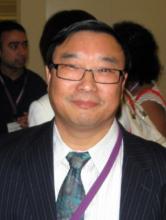ORLANDO – Electroconvulsive therapy was safe and effective for treatment of refractory agitation in patients with dementia, including those with multiple medical comorbidities, in the largest case series reported to date.
"This was true at least in the short term. Long term, there are no data," Dr. Yilang Tang noted at the annual meeting of the American Association for Geriatric Psychiatry.
He presented a retrospective chart review of the 38 patients with dementia who received ECT for agitation at Emory University’s Wesley Woods Geriatric Hospital in Atlanta during 2012.
On admission, patients were on an average of six psychotropic medications, including two or more antipsychotic agents in half of cases. The subjects averaged 6.2 Axis III diagnoses. Patients received a mean of 10.2 and median of 6 ECT treatments. The ECT was performed initially with right unilateral electrode placement in 35 of 38 patients; however, 6 patients were switched to bifrontal placement after four to six sessions because of poor response.
The mean baseline total Pittsburgh Agitation Scale score was 9.2. At discharge, after an average length of stay of 26 days, all patients demonstrated a significant reduction in their agitation score, with a median 8-point drop from baseline. Two patients had transient increases in their agitation score, from 7 points to 11 in one case and from 3 points to 7 in the other, but they improved with maintenance ECT after their acute course of therapy. In addition, patients went from an average of six psychotropic medications at admission to five at discharge, according to Dr. Tang, a psychiatric resident at Emory University in Atlanta.
Most patients were discharged after four to six ECT sessions, although seven patients received more than 12 treatments, mostly delivered as outpatient maintenance therapy.
One patient experienced transient ECT-related delirium. Yet no major treatment-related medical complications occurred, even though 7 patients had coronary artery disease, 24 were hypertensive, 3 had a history of stroke, and 3 patients had heart failure.
Only 2 of 38 patients were readmitted within 1 year after discharge, one of whom got another course of ECT. Although the possibility of readmission at other facilities can’t be ruled out, it seems unlikely that this occurred often, since patients’ surrogates were pleased with the post-ECT clinical improvement, Dr. Tang observed.
Agitation is one of the most distressing behavioral manifestations of dementia for patients, caregivers, and hospital staff. No medication has demonstrated effectiveness in treating this condition.
Subsequent to Dr. Tang’s presentation, two distinguished senior geriatric psychiatrists weighed in on the question of whether ECT has a legitimate role in treating agitation and other behavioral disturbances associated with dementia.
"It’s an unconventional use of the therapy. I would say it would be a fairly rare occurrence. It should not be something that is done commonly," asserted Dr. W. Vaughn McCall, professor of psychiatry and health behavior at the Medical College of Georgia, Augusta.
"Remember, the FDA indication for ECT does not include that particular use, although like with medications, you have the right to use a device off label if you can justify it. I would say the key in justifying it is to make sure you’re treating the patient’s distress and [you’re not using it] for the benefit of the nursing home staff. If you’re going to use ECT for a patient with dementia-associated agitation, it needs to be crystal clear that this is being done for the benefit of the patient, that the patient is in distress, and if you can also make the case that there is a concurrent depression along with the major neurocognitive disorder, then possibly you could justify using ECT if all other options have been exhausted," he added.
His fellow panelist Dr. George T. Grossberg took a more expansive view of ECT in patients with dementia.
"We do recommend ECT for patients with major neurocognitive disorders, either in instances where they have severe or treatment-resistant depression in the context of Alzheimer’s disease – where they tend to respond very well – or on rare occasions in treatment-resistant agitation. After we’ve tried everything else possible and they’re just really difficult to manage, I think a trial of ECT may be warranted. It has a calming, dampening effect on agitation and irritability," said Dr. Grossberg, professor of psychiatry, anatomy, neurobiology, and internal medicine at Saint Louis University.
"One thing it’s important to keep in mind is that if you have depression in the context of Alzheimer’s disease, and you decide to go with ECT because the depression is so severe or refractory, cognition will actually improve. When the depression starts to lift with the ECT, confusion and cognitive impairment will also improve. So I would keep ECT on the agenda," the geriatric psychiatrist added.



